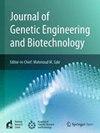A simplified, one step technique for disinfection of non-hardened rainbow trout eggs with tosylchloramide (Chloramine T) and peroxide (Wofasteril) compounds and the effects on bacterial load and microbiome composition in comparison to iodophore disinfection
IF 2.8
Q3 Biochemistry, Genetics and Molecular Biology
Journal of Genetic Engineering and Biotechnology
Pub Date : 2025-07-28
DOI:10.1016/j.jgeb.2025.100541
引用次数: 0
Abstract
Disinfection of the interior of non-hardened eggs with iodophors (Buffodine®) is an established hygienic practice in salmonid aquaculture to prevent pathogen transmission from the broodstock fish to their offspring. As iodophors inhibit sperm motility, fertilization is first performed in a 0.75 % NaCl solution, followed by egg disinfection in a second step after fertilization is complete. Although this two-step egg disinfection procedure is simple to perform under laboratory conditions, it presents challenges for fish farms using mass stripping. The process involves two highly time-sensitive steps, requiring precise execution, as any errors can lead to fertilization failure or ineffective disinfection. A more practical approach would be to simplify disinfection into a single-step procedure. The present study demonstrates that non-hardened rainbow trout eggs can be fertilized and disinfected simultaneously using a one-step method with tosylchloramide (100 mg/l Chloramine T®) or peroxide (100 µl Wofasteril®) compounds in 0.75 % NaCl for 40 min. This procedure is feasible as the applied concentrations of Chloramine T and Wofasteril have only low impact on sperm motility. The one-step methods do also not negatively impact embryo and early larval development. Non-hardened rainbow trout egg disinfection methods with Chloramine T and Wofasteril were as effective as the conventional Buffodine method in reducing total bacterial load of eggs at 3 h post-fertilization (hpf), the point at which water hardening is complete. Reanalysis of total bacterial load after 22 days of development (embryo stage at the onset of eye pigmentation) proved Chloramine T more effective than Wofasteril and Buffodine. Microbiome composition differed significantly across developmental stages and disinfection treatments. Notable variations were observed between non-disinfected controls and eggs treated with Buffodine, Chloramine T, or Wofasteril, in persistent bacterial communities, stage-specific bacteria, and bacteria colonizing the chorion during embryogenesis. Buffodine treatment increased bacterial diversity, while Chloramine T and Wofasteril led to reduced diversity compared to the control. These findings are discussed in the context of microbiome stability and resilience, key factors for long-term fish health. In summary, the simplified one-step disinfection protocol offers practical advantages in reducing time-sensitive handling steps and improving efficiency in large-scale aquaculture operations. Moreover, it is environmentally preferable as both Wofasteril and Chloramine T are used at lower concentrations than Buffodine and degrade rapidly in water, leaving no harmful residues.
甲氯胺(氯胺T)和过氧化物(沃法斯特利)化合物对未硬化虹鳟鱼卵的简化一步消毒技术及其对细菌负荷和微生物组组成的影响与碘伏消毒的比较
在鲑科水产养殖中,用碘伏(Buffodine®)对未硬化的卵进行内部消毒是一种既定的卫生做法,以防止病原体从亲鱼传播给它们的后代。由于碘伏抑制精子活力,首先在0.75%的NaCl溶液中进行受精,然后在受精完成后的第二步对卵子进行消毒。虽然这种两步鸡蛋消毒程序在实验室条件下操作简单,但它对使用大量剥离的养鱼场提出了挑战。这一过程包括两个对时间高度敏感的步骤,需要精确执行,因为任何错误都可能导致受精失败或消毒无效。更实际的方法是将消毒简化为一步程序。本研究表明,未硬化的虹鳟鱼卵可以同时受精和消毒,使用tosylchloramide (100 mg/l Chloramine T®)或过氧化物(100µl Wofasteril®)化合物一步法在0.75% NaCl中消毒40分钟。该方法是可行的,因为氯胺T和Wofasteril的使用浓度对精子活力的影响很小。一步法也不会对胚胎和早期幼虫发育产生负面影响。在受精后3小时(即水硬化完全的时间点),氯胺T和沃法斯特利对未硬化的虹鳟鱼卵进行消毒,其效果与传统的布法定方法一样有效。发育22天后(眼球色素沉着开始时的胚胎阶段)的总细菌负荷再分析证明氯胺T比沃法司特利和布非定更有效。微生物组组成在发育阶段和消毒处理之间存在显著差异。在未消毒的对照组和用布布定、氯胺T或沃法司特利处理的鸡蛋之间,在持续的细菌群落、阶段特异性细菌和胚胎发生期间绒毛膜定植的细菌方面观察到显著的变化。与对照组相比,布非定处理增加了细菌多样性,而氯胺T和沃司特利导致多样性减少。这些发现在微生物组稳定性和弹性的背景下进行了讨论,这是鱼类长期健康的关键因素。总之,简化的一步消毒方案在减少对时间敏感的处理步骤和提高大规模水产养殖作业效率方面具有实际优势。此外,与布布定相比,Wofasteril和氯胺T的使用浓度较低,在水中降解迅速,不会留下有害残留物,因此对环境更有利。
本文章由计算机程序翻译,如有差异,请以英文原文为准。
求助全文
约1分钟内获得全文
求助全文
来源期刊

Journal of Genetic Engineering and Biotechnology
Biochemistry, Genetics and Molecular Biology-Biotechnology
CiteScore
5.70
自引率
5.70%
发文量
159
审稿时长
16 weeks
期刊介绍:
Journal of genetic engineering and biotechnology is devoted to rapid publication of full-length research papers that leads to significant contribution in advancing knowledge in genetic engineering and biotechnology and provide novel perspectives in this research area. JGEB includes all major themes related to genetic engineering and recombinant DNA. The area of interest of JGEB includes but not restricted to: •Plant genetics •Animal genetics •Bacterial enzymes •Agricultural Biotechnology, •Biochemistry, •Biophysics, •Bioinformatics, •Environmental Biotechnology, •Industrial Biotechnology, •Microbial biotechnology, •Medical Biotechnology, •Bioenergy, Biosafety, •Biosecurity, •Bioethics, •GMOS, •Genomic, •Proteomic JGEB accepts
 求助内容:
求助内容: 应助结果提醒方式:
应助结果提醒方式:


